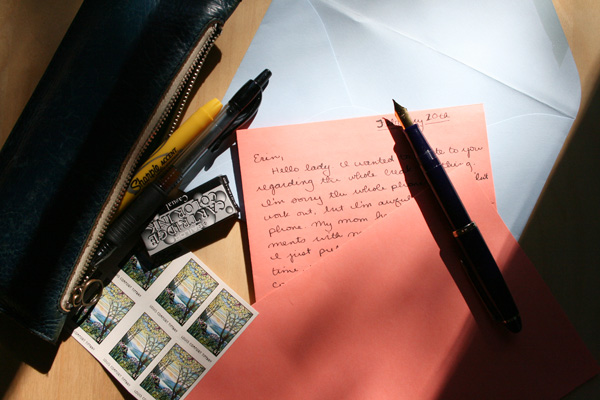Letter - Writing
Sakshi Education
By P. Mohan Chandran


In today’s world of communication, letters are one of the most used communication instruments in everyday life. Letters are used both for personal as well as official communication. We write letters to friends, relatives, parents, colleagues, government and private officials, etc.
Letter-writing demands lot of care and caution. Apart from communicating what you want, a letter also conveys to the reader your image, attitude, beliefs, and personality. A well-written letter can elicit the desired response from the reader, while a letter with spelling errors, wrong choice and usage of words, grammatical errors, and incomplete or half-baked information can not only hurt the reader’s feelings, but also send a wrong impression about the writer. Every educated person should know how to write a clear and easily readable letter. Everyone has to write letters of some kind, and may face problems in writing an important letter that may affect his career interests significantly. Therefore, the art of letter-writing is not just an ornamental accomplishment, but something that has a lot of practical relevance, too.
There are different kinds of letters, such as friendly letters, business letters, social letters, etc., each of which has its own particular form, but there are certain matters of form that are standard, and hence apply to all kinds of letters. In all kinds of letters, there are the following six points of form that must be included:
1. The Heading (which consists of the writer’s address and the date)
2. Salutation (or, the courteous greeting)
3. The Body of the letter (also called ‘The Communication’ or ‘Message’)
4. The Subscription (or, the courteous leave-taking, or ‘Conclusion’)
5. The Signature (or, the name of the writer)
6. The Superscription on the envelope (or, the recipient’s address)
THE ELEMENTS OF A LETTER
Letter-writing demands lot of care and caution. Apart from communicating what you want, a letter also conveys to the reader your image, attitude, beliefs, and personality. A well-written letter can elicit the desired response from the reader, while a letter with spelling errors, wrong choice and usage of words, grammatical errors, and incomplete or half-baked information can not only hurt the reader’s feelings, but also send a wrong impression about the writer. Every educated person should know how to write a clear and easily readable letter. Everyone has to write letters of some kind, and may face problems in writing an important letter that may affect his career interests significantly. Therefore, the art of letter-writing is not just an ornamental accomplishment, but something that has a lot of practical relevance, too.
There are different kinds of letters, such as friendly letters, business letters, social letters, etc., each of which has its own particular form, but there are certain matters of form that are standard, and hence apply to all kinds of letters. In all kinds of letters, there are the following six points of form that must be included:
1. The Heading (which consists of the writer’s address and the date)
2. Salutation (or, the courteous greeting)
3. The Body of the letter (also called ‘The Communication’ or ‘Message’)
4. The Subscription (or, the courteous leave-taking, or ‘Conclusion’)
5. The Signature (or, the name of the writer)
6. The Superscription on the envelope (or, the recipient’s address)
THE ELEMENTS OF A LETTER
- The Heading: The Heading informs the reader ‘when’ and ‘where’ you (or the sender/writer) wrote the letter. It includes the writer’s full postal address, and enables the reader to reply to the sender. The ‘when’ part allows the reader to know the date on which the letter was written.
The Heading should be positioned on the top right-hand corner of the first page. The address should come first, followed by the date, as shown below:
80-41, M.G. Road
Hyderabad 500 015
4 January, 2011.
The Heading and the date may alternatively go on the top left-hand corner (which is considered as the American style).
The date may be written in any of the following ways:
(a) 4 January, 2011
(b) 4th January, 2011 (never write January 4th, 2011)
(c) January 4, 2011
(d) 4-1-2011
(e) 4.1.2011
(f) 4/1/2011
NB: To a Britisher, (d), (e), and (f) means the fourth of January; to an American, it means the first of April. Remember that Americans mention the month first and the date next, while the Europeans write the date first and the month next. In order to avoid confusion, it is better to always write the month in words (i.e., 4 January, or January 4, or 4th January).
- Salutation (or Greeting): Salutation or greeting is the way you address the reader of the letter. The form of greeting will depend upon your relation with the recipient of the letter. In North India, the last name or ‘surname’ is used to address a person. For instance, if a person’s name is Vedantam Sharma, he is addressed as ‘Sharma.’ In South India, the first name is used to address a person.
Another important aspect in addressing a person is that if someone is a doctor, we address him as ‘Dr. Vedantam Sharma.’ But, in the case of a woman, we should know whether she is married or not. If you are addressing a married woman, you can use ‘Mrs. Dipti.’ If the woman is single, then use ‘Miss. Dipti.’ If you are not aware of the marital status, then it is advisable to use ‘Ms. Dipti.’
The following are some instances of salutation to different people:
Members of your family: Dear Father, My dear Mother, Dear Uncle, Dear Sister, Dear Brother, Dear Ravi, etc.
Friends: Dear Shri Santosh, or Dear Santosh, or Dear Rajesh, etc.
Business People: Dear Sir, Dear Sirs, or Mr. Anil Ambani, etc.
The position of the Salutation is at the left-hand of the first page at a lower level than the Heading. For instance:
80-41, M.G. Road
Hyderabad 500 015
4 January, 2011.
Dear Santosh,
NB: The use of the term “dear” is purely formal, and just a polite expression, and does not necessarily imply any special affection.
- The Body of the letter (‘Communication’ or ‘Message’): The body of the letter is the actual letter itself, and the style in which you will write the letter will depend upon the kind of letter you want to write. The style of a letter to an intimate friend will obviously differ from that of a purely business letter, or an official correspondence. The following are a few hints that you can apply to all kinds of letters to make it clutter-free and appealing:
- Divide into paragraphs: Unless your letter is short, it is always better to divide the letter into several paragraphs. This could also help you in varying the subject matter with ease.
- KISS (Keep It Short and Simple): Use simple and direct language, and short sentences. Don’t use bombastic language, jargons, idioms, phrases, proverbs, or long/compound words. Be clear what you want to say and say it with as few and as simple words as possible.
- Be complete: Don’t miss out on anything that you want to say in the letter. It reflects poorly on you when you forget something and have to add postscripts at the end of the letter. Think out what you want to say before you begin to write the letter, and put down your points in a logical sequence.
- Write Neatly: Ensure that whatever you write is neat and legible to your reader. Do not give the reader unnecessary hardship with your poor penmanship and sloppy writing.
- Mind Your Punctuation: Be careful about your language. Use proper punctuation and insert commas, semicolons, and full stops in their proper places. Incorrect punctuation may alter the entire meaning of a sentence.
- The Subscription (or Leave-taking): Subscription is the way you take leave from the reader in a letter. A letter should not end abruptly, just with the writer’s name since it would look rude. You should follow certain forms of leave-taking as follows:
Yours sincerely, Your sincere friend, Yours faithfully, Yours truly, etc.
Different forms of leave-taking are used in different kinds of letters and they have to correspond properly to the sender/reader. The subscription, or leave-taking phrase, must be written below the last words of the letter, and to the right side of the page. This is the traditional method (British style). However, now-a-days, there is a growing tendency to place the subscription on the left side (American style). For instance:
Sincerely yours
NB: The first word of the subscription must begin with a capital letter. However, the first letter of the second word must not be capitalized.
- The Signature (or name of the writer): The signature must come below the Subscription. For instance:
Yours sincerely,
Amitabh Bachchan
The signature should be clearly written in letters to strangers, so that the reader knows whom to address in reply. A woman should prefix to the name ‘Miss’ or ‘Mrs’ (or ‘Kumari’ or ‘Smt’) in brackets. ‘Ms’ can be used by a woman who does not wish to be called ‘Miss’ or ‘Mrs.’ For instance:
Yours faithfully,
(Mrs.) Meenakshi
- The Superscription on the envelope: The address on the envelope should be written legibly, as depicted below:
AIR MAIL
Miss. Dipti
41, Banjara Hills
Sri Krishna Nagar
Hyderabad - 500025
Published date : 24 Jan 2011 07:15PM









